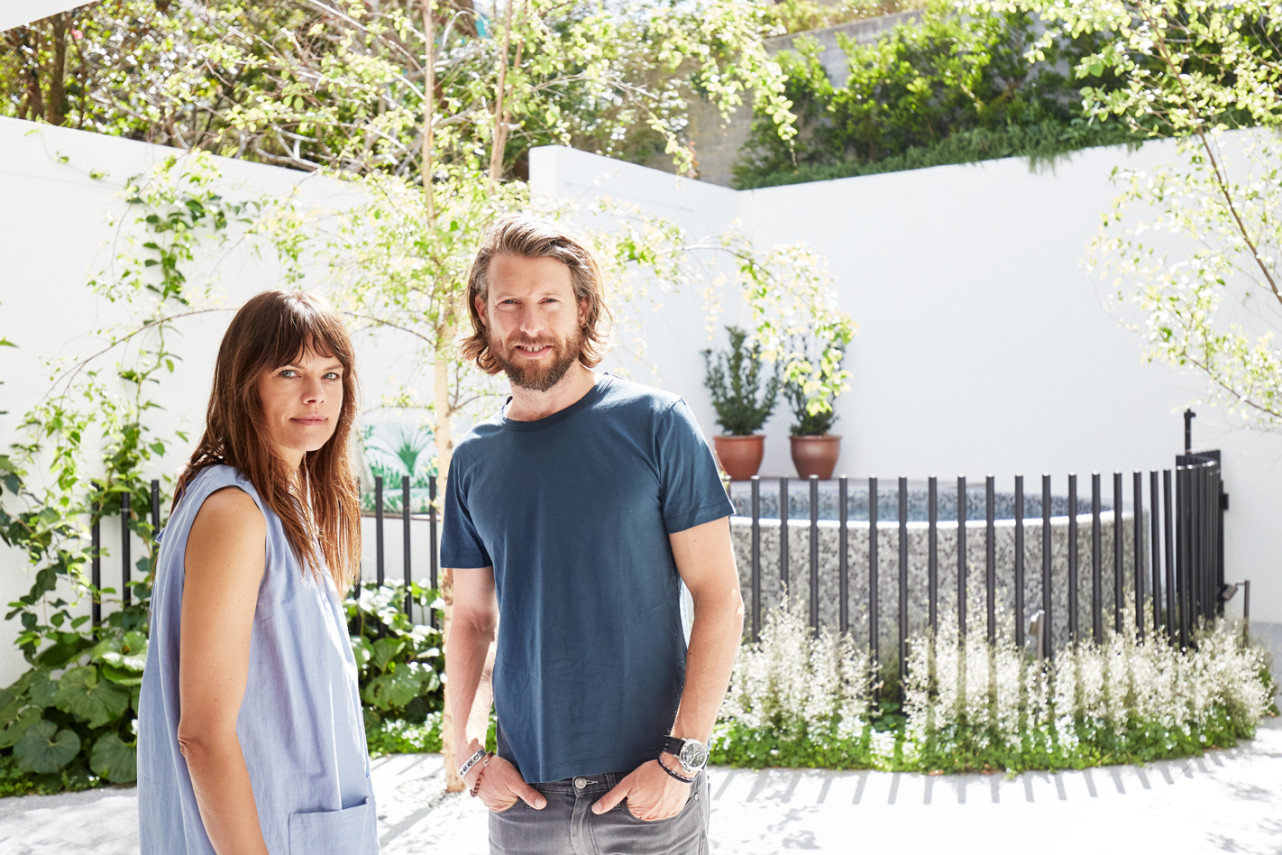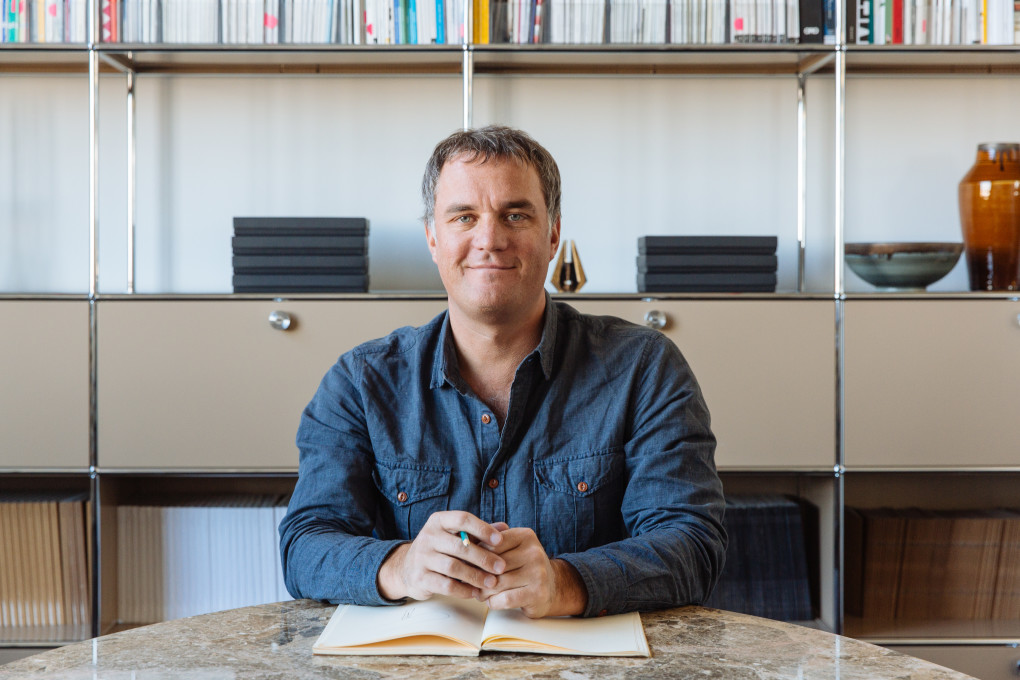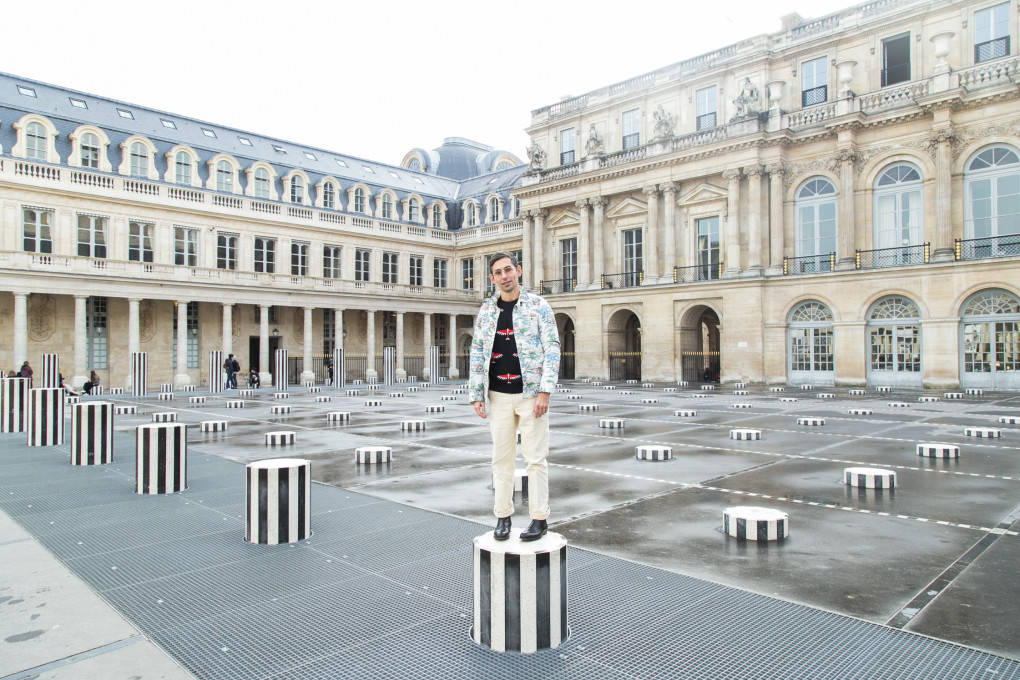Nick Tobias and Miranda Darling
Architect and Writer
20. February 2017
Sydney
Architect Nick Tobias and his wife, writer Miranda Darling, live in a world enriched by art, travel, meditation, and the community of ocean denizens on the doorstep of their North Bondi home in Sydney. Working predominantly on upscale private residences, Tobias’s award-winning firm of 17 years, Tobias Partners, aims to “create spaces and elements that nourish and uplift.” Tobias, who grew up on Sydney’s harbour, is a collector and patron of contemporary art and a born-and-bred water junkie. We met the peripatetic couple at their light (and art) filled home, where they shared a little window into their world.



Nick, you recently won the People’s Choice National Architecture Award for Bondi waterfront home, Deepwater. Is water integral to your work?
Nick: Very. I suppose we work a lot in my backyard. A lot of my projects are in the area that I grew up in, so it’s a place I know very intimately, geographically and topographically and the interface between land and water. That’s always been fascinating to me. When I think about our work, I think about living on the edge and capturing that in our buildings—both in form and materiality but also in terms of experience and user connection.
How do people come to you?
Nick: I think when people want to do a project, obviously word of mouth, publications, awards… Social media is starting to come into play even for architects.
How does your practice approach social media?
I think the nice thing about social media for architects is its fluidity and spontaneity and the ability to show off process and behind-the-scenes—how you get to that end product is a nice thing for us to be able to show people. And I think it’s an important thing for people to understand. To see images of drawings and sketches and models and things happening in the studio and things happening on site and things that are influencing and inspiring us. These are all the different inputs that are happening to a project over its life.

“The arts and creativity have been a constant in my life, in various manifestations.”



What makes you say ‘yes’ or ‘no’ to a project?
Nick: The most important ‘yes’ is a cultural fit between us and a client. The closer you see eye-to-eye in terms of values, ethos and objectives is the most important thing. I hate to say, but over the years project scale has come into play. Most of the houses we do have budgets of $3 million and up. We do some smaller ones, where somebody wants to do a special little addition to a house or wants to do something that’s particularly interesting but small. We do work outside houses: hospitality, retail, commercial offices and exhibitions, and those projects can be really small—a $100k or $200k job. That bit of diversity is really healthy for the practice, both in terms of doing something different but also broadening our skill set. And outside those things we also do other projects like small designer boutique developments, adaptive reuse—we’re doing some funeral chapels at the moment. I don’t imagine that houses would ever become less than 50 percent of what we do. To date, we don’t really work for developers… We may make a decision one day when we find a developer that’s a cultural match for us, but I think that’s a challenge.
Does philanthropy tie into the mix?
Nick: It does, but more so on a personal level. I take a pretty active role in a number of contemporary art-related things and that’s probably where I do most of my philanthropic work. My general overarching philosophy, that sits above architecture itself, is across the arts and design—how can I make a difference in how people value the arts? The arts (and I include architecture, even though it’s quite scientific) is our form of creative expression and I think that’s fundamental to human development, evolution, happiness, communication, which ultimately creates important conversations about the world.
How did you begin collecting contemporary art?
Nick: The arts and creativity have been a constant in my life, in various manifestations. Collecting art is not just collecting art, it’s engaging with art, galleries and, most interestingly, with artists. Where it started for me, I was about 21 and I had a friend and mentor who said, ‘I think you need to look at this…’ and started taking me gallery trawling and putting artwork in front of me that was different and challenging and unexpected. So I got the bug at that point. The first thing I collected, she actually introduced me to a young artist who was about my age and got a conversation going between us that resulted in a commissioned work. And that was really where I understood the value of collecting art from contemporaries and also buying art—you can’t do it all the time—but from an artist you might have met or had a conversation with. That adds an extra layer of connection to it. It started as a solo mission and then when Miranda and I got married, it became a nice joint project for us.
Miranda: I love collecting contemporary art by living artists, because I really enjoy engaging with the artists themselves. Most of the works in the house—certainly the more recent ones—we’ve met the artist and had a chat and been to the studio or had dinner with them.


“I’ve always loved the aesthetic of USM, and for this house I particularly liked the lightness of it—this kind of crystalline structure that I find quite enchanting.”
You have a wonderful art collection in your home. How did it come together?
Miranda: I love having a mix, for example, the Papua New Guinean mask with the moth head and the bone through its nose that my father collected from New Guinea in the ’60s, alongside the piece by Claire Healy and Sean Cordeiro of the Challenger space shuttle explosion (made of LEGO). And we’ve also done quite a crowded hang, which I really like. In this house, it’s not just one painting for on wall, it’s more energetic in that way. Because there isn’t a lot of space and there aren’t 100 rooms, and that’s really fun.
The interior design is equally diverse.
Miranda: It was quite organic in the sense that it was immediately obvious what everything had to be. There wasn’t a lot of umm-ing and ahh-ing or trying out a lot of ideas. It almost came fully conceived. And funnily enough, I think Nick and I had almost identical visions. It came together with a slither of that mint green carpet we’ve got upstairs in the library. The minute I saw that color, I knew the wood I needed to buy and the colours—it had a certain feel to it straight away. And that feel was what I used as a touchstone for all the decisions.
Nick: Downstairs we have a cinema room. It’s blue velvet, blue carpet, blue walls. We’ve got these punches of color in these contained blocks, and the neutral terrazzo floor [throughout]. We have my grandmother’s chairs that we re-upholstered, there’s a contemporary Minotti thing… an old Afghan rug, a silk rug Miranda picked up, a sculptural chair, and an ’60s Italian [piece]...so it’s quite eclectic. The marble and the copper give it another strong punch of color. The piano was my grandmother’s—it’s a 1906 Steinway, and there’s a Hiromi Tango piece hanging above and a Tjanpi Weavers indigenous piece sitting below. Upstairs, there’s the Ryan McGinley [photograph] and some video work, and a Daniel Boyd and Fiona Lowry, and the USM unit.
Miranda: My mum’s Swiss and we grew up all over. Certainly in Switzerland I remember seeing USM everywhere, from offices to people’s homes. I’ve always loved the aesthetic, and for this house I particularly liked the lightness of it—this kind of crystalline structure that I find quite enchanting. And the idea of being able to populate it with everything from books to objects and have it as a revolving cabinet of curiosities, I think is really nice.
Tell us about incorporating USM furniture into your home.
Nick: Both Miranda and I have always wanted some USM furniture—this is natural as I am an architect and she is Swiss!
In practical terms we were looking for a creative and flexible way to divide the living areas in our home and USM gave us that ability in a stylish and timeless way. We were able to custom design the units to suit our needs precisely, however the units also provide spaces that can grow with us as we settle in.
Miranda: We were very taken with the lightness of the USM product we chose to use. It works as both a separation but also as a transparent layer of interest — dividing the room into more liveable spaces while retaining the sense of scale and the light/view from the street.
Why did you choose them to be designed them this way and how do they fit with your interior aesthetic at home?
Nick: The process of design was simple and exciting. We had the overall proportions we wanted to make the units and then started to play with the USM components so that we could display and store different things and also finesse the aesthetics. The form of the design essentially follows the functions we required however we also worked with different sized modules simply to be playful.
Miranda: We both have an informal and very personal collection of objects that have in many instances been inherited or otherwise acquired with an interesting story attached; the structure of the USM furniture and its flexibility allows us the possibility of playing with the displays and curating them in the style of ’curiosity cabinets.’ They almost appear to hover in our living space.




You have two young sons, yet it doesn’t feel like your home panders to any ‘child-friendly’ constraints.
Miranda: The kids are just part of our life and they’ve always been around beautiful things. Even when they were very young, we never put away the little figurines or hid the art, because if they grow up around it…. They know not to throw their balls in the house [laughs]. That’s part of their education, to be around art. But we’ve also thought about the way we live as a family, day-to-day life and how the space is going to be used. The boys’ bedrooms, for example, have these separated spaces—one for each boy—but then there’s a shared play area because they do like to share a room, and the beds are bunk beds because they like to have their friends over, and there’s a balcony so they can play outside when it’s raining. Downstairs, we have a craft room, because I do a lot of crafts, and they come down and make stop-motion films and smash their cars and they can paint and make as much mess as they want without having to be precious about things. I want them to feel that it’s their house as well.
And you take them travelling everywhere with you, too?
Nick: Miranda was always a nomad—that was her life. And that’s probably what has driven our life in that respect. I’ve grown up in Sydney and worked in Sydney and never lived overseas. So we’ve travelled a lot. We travel to Switzerland a lot because we have family there. We really make it a big priority and kids never got in the way of that. It wasn’t easy, but it means that they are such easy travellers now.
Miranda: I’ve grown up half my life here and half my life everywhere else, so to me [travel] is as necessary as breathing. It’s the way I recharge and reconnect with everything. With the house, as well, we consciously decided that one of the things we wanted to be able to do is lock it up and leave it, so for example, not having a really elaborate garden—things that suffer when you’re not there for a month or two or three at a time. Also, we bring things back; we bring back ideas. I like to think that our perspective is pretty broad and pretty global on everything, including design, art [and] the way you live, which I think comes from travelling. I really want to encourage that in my boys, and that’s why they have travelled since they were little, because I want them to know that this is home but other places can be different and still feel good. That different is a good thing—and to make them curious and spur them to keep questing and keep their horizons as broad as possible.
How would you describe each other’s style?
Nick: Her pre-marriage style I’d say was in some ways quite traditional. She’s like a granny with a real rockstar edge. So silk shirts and skirts, always wearing pearls…but then always with something quite punchy and edgy to offset that. As the years have gone on, she’s still got that but she’s also got a slightly more ’70s French, androgynous vibe—often wearing very high shorts and pants [laughs].
Miranda: It depends on whether he’s off to work or not [laughs] but when he’s in the classic ‘I’m off to the office’ style, I like to describe him as a 1960s Parisian professor. Around the time of the ’68 riots—he’s got the glasses, the houndstooth jacket, the jeans, the slender frame.






“That practice of going in, in order to project out, rather than looking out in order to project out is an important part of my architectural practice.”
Your meditation practice is a key part of your life and work, too…
Nick: I learned from a guy named Tom Knoles 25 years ago. So I’ve had this very long association with transcendental meditation. Tom lived [in Sydney] for at least 15 years and he established a TM community here. I was really lucky, I was 15 years old and my mother took me. And not only did I learn the practice but I spent a lot of time with Tom, going to his center and being played a lot of tapes from his master, Maharishi Mahesh Yogi. I found that really impactful at that age. It’s a practice I’ve always kept up. Miranda, my brother, my sister, my children—most people around me practice TM. So I’ve done quite a bit in the area of Vedic studies and retreats, it’s a big part of my life. At the end of the day, it connects with my work from the sense of source of creativity and pure consciousness. The more conscious I am, the more diligent I am about my practice. But certainly from a creative point of view, I feel like I have the ability to dive much deeper into that reservoir and come up with ideas that are much more original, unique and intuitive. That practice of going in in order to project out, rather than looking out in order to project out is an important part of my architectural practice.
What do you love about your North Bondi neighborhood?
Miranda: I love that—it sounds like a bit of a cliché—but it really is a bit of a village in the sense that there are familiar faces around all the time, people you say hello to. In this area, being friendly is a good thing and if you’re not friendly, there’s something wrong with you. Whereas in other parts of town, it’s like, ‘Why are you smiling?’ [laughs] People actually want to engage with each other. And most people who don’t live here come here for pleasure, so they’re exercising and going to the beach, so there’s a really nice atmosphere. And you can walk everywhere, which I love because I don’t like driving. So I have my little granny trolley that I take to the weekend markets. And for the kids, to be able to run to the corner shop themselves and get me something, it’s a really nice way to live.




Thank you, Nick and Miranda for showing us your beautiful home and telling us about all the little details that keep you returning after your many travels. See some of the work that Nick’s firm, Tobias Partners does on their website.
This portrait was produced by the international interview magazine Freunde von Freunden. Find more USM furniture for your home and workspace here.


